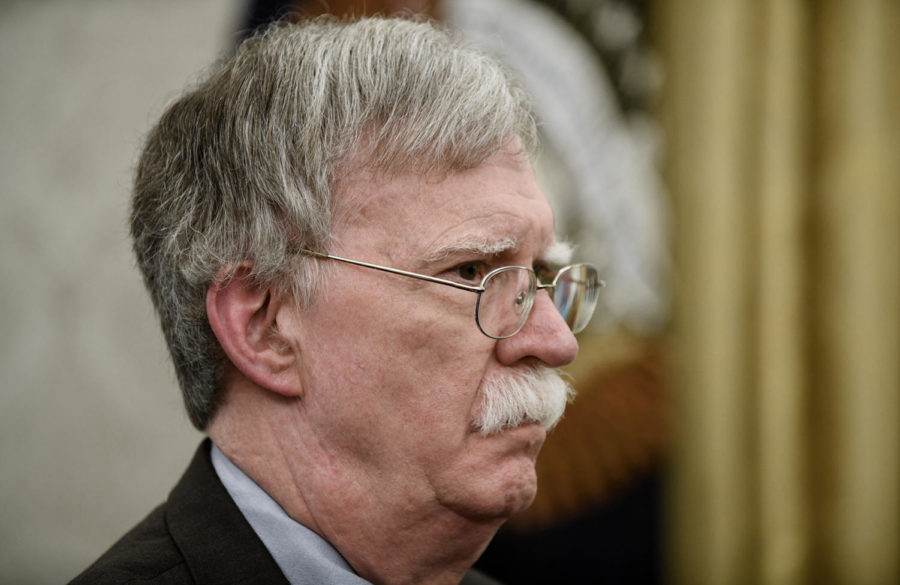Bowing to Congress, Trump scales back proposed space force
Olivier Douliery/Abaca Press/TNS
National security adviser John Bolton listen to U.S. President Donald Trump about the new directive centralizing all military space functions under a new Space Force, which will be overseen by the Department of the Air Force, in the Oval Office of the White House on Tuesday, February 19, 2019, in Washington, D.C.
February 19, 2019
Bowing to bipartisan concerns in Congress, President Donald Trump retreated Tuesday from his plan to create an independent space force in the Pentagon, proposing instead to consolidate the military’s space operations and personnel in the Air Force.
The scaled-down plan would still establish a new military service focused on war-fighting in outer space, the first new branch since 1947, with a four-star commander who would become a member of the Joint Chiefs of Staff, according to an executive order Trump signed Tuesday.
“My administration has recognized space as a war-fighting domain, and made the creation of a space force a national security priority,” Trump told reporters in the Oval Office.
Keeping the new service within the Air Force, much like the Marine Corps is administratively part of the Navy, was a concession to key lawmakers, who are intent on protecting the Air Force role in space and who oppose adding new layers of Pentagon bureaucracy and billions of dollars in additional costs.
But even administration officials said those concessions may not be enough to get the White House proposal through Congress, which must approve a new military service.
“I think it can get done this year, but Congress has a lot to do and we defer to them,” said a senior administration official who discussed the proposal on the condition he not be identified.
Trump began touting the space force at political rallies last summer, after he was lobbied by several members of Congress who had pushed the idea since 2016.
Supporters, including some at the Pentagon, say a dedicated space force is needed to bolster U.S. security because Russia, China and other adversaries are building anti-satellite and other weapons that could threaten the U.S. military’s dominance in space.
Trump called last June for creation of a space force as a sixth branch of the military, co-equal with the Army, Navy, Air Force, Marine Corps and Coast Guard.
“We are going to have the Air Force and we are going to have the Space Force: separate but equal, it is going to be something so important,” Trump said at the time.
The White House declined to release a cost estimate for its new plan, saying the details were still being finalized. But Pentagon officials said the space force would start small, with only a headquarters and several existing space organizations under its purview.
Putting the space force within the Air Force probably would keep the initial cost below $100 million, according to the U.S. official.
That compares with an initial Air Force estimate last year that establishing a separate service would cost $13 billion over five years. That estimate equaled the existing Pentagon spending on space and was widely seen as a ploy by the Air Force to kill the space force.
By keeping the organization small at first, the White House is hoping to undercut opposition in Congress.
“We’ll be moving fairly slowly, focusing on the headquarters” at first, the official said.
Over time, the goal is to shift military personnel responsible for the Pentagon’s role in space into the new force, and to transfer existing military organizations that are responsible for acquisition of satellites and other space systems into the new organization, officials said.
The force will also gradually take over responsibility for training personnel from other space-related services. The force will be overseen by a civilian undersecretary of space, who will report to the secretary of the Air Force and must be confirmed by the Senate.
Under the plan, the Air Force’s existing Space Command will be elevated into a full-fledged “combatant command” that will take over responsibility for military operations in space, including war-fighting, if necessary, officials said. The National Reconnaissance Office, which builds spy satellites and is jointly run by the Pentagon and the intelligence community, would not be part of the space force.
The federal government’s civilian space agencies, such as the National Aeronautics and Space Administration and the National Oceanic and Atmospheric Administration, also would remain separate.
Key lawmakers, including Rep. Adam Smith, D-Wash., who chairs the House Armed Services Committee, have expressed concern that the space force would create an expensive new Pentagon bureaucracy and could end up harming military space operations.
The plan also faces opposition from Republicans in the Senate.
Under the order approved by Trump, the secretary of defense is periodically review whether a space force entirely separate from the Air Force is necessary.
“We haven’t abandoned that goal, and in fact we’re achieving, I think with this directive, the president’s No. 1 objective, which is a separate armed service,” the administration official said.
“We’ve heard the concerns from Congress about not creating a large bureaucratic organization, and I think our thought was if we start going directly to a military department, which I think is our desired end state, then we would spend a lot of time dealing with bureaucracy and structure and not focusing on war-fighting,” the official added.



